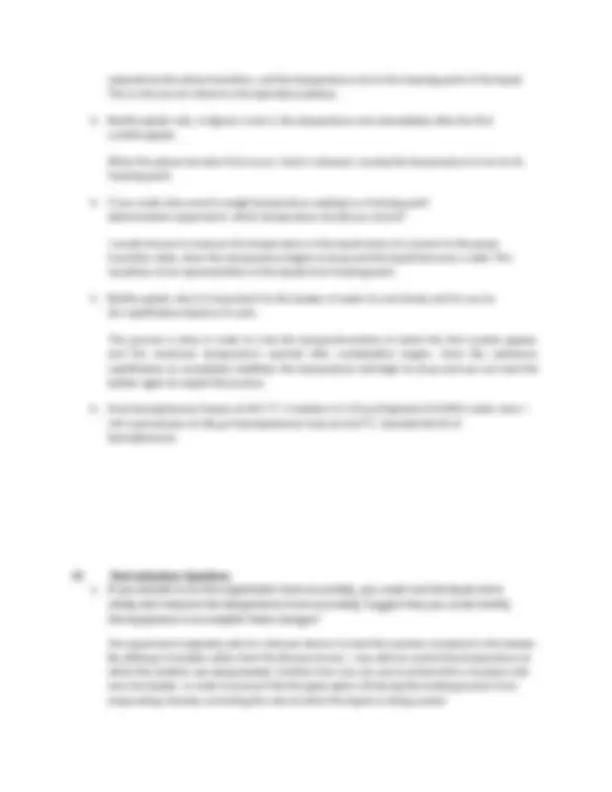




Study with the several resources on Docsity

Earn points by helping other students or get them with a premium plan


Prepare for your exams
Study with the several resources on Docsity

Earn points to download
Earn points by helping other students or get them with a premium plan
Community
Ask the community for help and clear up your study doubts
Discover the best universities in your country according to Docsity users
Free resources
Download our free guides on studying techniques, anxiety management strategies, and thesis advice from Docsity tutors
CHEM1046 Determining Molar Mass by Freezing-Point Depression in Naphthalene EXP 2025
Typology: Lab Reports
1 / 4

This page cannot be seen from the preview
Don't miss anything!



I. Determining Molar Mass by Freezing-Point Depression in Naphthalene PROP 507, Determining Molar Mass by Freezing-Point Depression in Naphthalene Chemistry 1046L II. Purpose of Experiment The following experiment ask that you complete three consecutive procedures. The first being to determine the freezing of pure naphthalene, then the freezing point of a solution containing measured masses of naphathalene and biphenyl and finally to determine the molar mass of and unknwown substance. III. Background/Introduction When a pure liquid is at a higher temperature then its surroundings, the liquids temperture will begin to drop, releasing heat. As the liquid continues to drop it will eventually reach its freezing point. In this moment the liquid will enter a transition phase change, where the surrouding solution closest will go from being a liquid to a liquid plus solid. As the temperature continues to drop pass the freezing point it becomes ‘ supercooled ’, resulting in crystallization. At this point, the liquid will continue to solidify. We can state that a pure solution reaches its freezing point when it has reached equillibrium, whereas a solvent in a solution cannnot because it will not freeze at a constant temperature. When solutions are ‘ideal’ the freezing point of the the solvent in the solution is lower then the proportion of the solute particles. An ideal solution is one in which the vapor pressure that sits above a solution is proportional to the number of moles of the solvent. Colligative properties are proporites of solutions that depend entiretly on the number of dissolved particles in a solution, but not on the identities of the solutes. A representation of this can be seen in a mixture of salt water vs. pure water. The freezing point of salt water is lower that that of pure water, due to the presence of salt that is being dissolved in the water. IV. Summary of Experimental Procudures This experiment is divided into three parts as follows: Part I of this experiment deals with determing the freezing point of pure Naphtalene. You are asked to set up the equipment you will be using to carry out the experiment as shown in figure 3 in the lab manual. You are to
to measure the weight of your test tube, then add 5-6g of naphthalene and measure the mass again. You will be asked to record these masses after every weigh in. Afterwards, you will need to add tap water to the beaker until almost full, and heat the beaker and contents until the temperature reads between 85-90 degrees celcius. Once this stage is done you will need to let the beaker cool , stir the liquid contained in the test tube, and read the temperature at 1-minute intervals. Again, you will need to record this data (be sure to observe at what temperatures crystallization begins, and the temperature at which it occurred. You will do this until the naphthalene has completely solidified, and the temperature begins to drop. Heat the beaker and contents again until the naphthalene has melted. Remove the thermometer and the stirrer, allowing the naphthalene to drip back into the test tube. You will need to allow the naphthalene film to solidify. Clamp the thermometer an the stirrer in order to avoid contamination of the frozen naphtalene. Part II of this experiment will determine the Kf of Naphthalene. You are asked to weight the dry test tube you used in part I, and record it mass as p reviously done. Take between 09-1.3g of biphenyl to this test tube and record its mass. Reassemble the equipement as before and warm the beaker and contents until the solution in your test tube has melted. Just as previously done, you will remove the beaker and wait for the temperature to reach 85 degress celcius, the begin recording the temperature at 1-minutes intervals. Heat the beaker and contents again to allow melting, remove the thermometer and stirrer, thus allowing the solution to to drip back into the test tube. Inside the fume hood, pour the contents of the test tube into the container labled, ‘ Discarded Solutions’. You will need to clean out any traces of the solid from the test tube, thermometer and stirrer using Acetone. Discard any of these washings into the ‘Discarded Solutions container’ as well. Part III is asking you to determine the Molar Mass of 1g of an unknown. You will prepare the solution of naphthalene and 1g of unknown by weighing a clean test tube. Add 5-6g of naphthalene and weigh again. Transfer between 0.9-1.3g of unknown to the test tube and weight again. You will repeat the procedure carried out in part II in order to obtain the termperature and time date for your solution of the unknown and naphthalene. V. Pre-Lab Questions 1- What precautions should you take with naphthalene? When working with Napthalene, one should be sure to wear goggles a lab coat, and ensure to handle the chemical while working under a fume vent, in order to avoid inhaling any of the fumes given off by the chemical reaction. 2- Briefly explain why there is a constant-temperature plateau in the cooling curve in Figure 1 but not in figure 2. As a solvent crystalizes from a solution, the solute concentration increases, resulting in further lowering of the freezing temperature, as illustrated in Figure 2. In figure 1, we can see the phase change occur from a pure liquid to a liquid plus a solid. As the crystals begin to form, heat is
2- Pure biphenyl freezes at 71.0 C, a solution of 1.44 grams of anthracene (C4H10; molar mass 178.2 g/mol) and 12.87 grams of biphenyl froze at 21.1C, calculate Kf of biphenyl. 3- The freezing point of camphor is 178.4 degrees C and its molal freezing point depression constant is 37.7 degrees C x kg/mol. How many grams of napthalene (molar mass = 128.17 g/mol; a solute) should be mixed with 12.0 g of camphor to lower the freezing point to 170.0 degrees C? 4- Suppose that a student calculated Kf of biphenyl to be 81.2 celsius x kg/mol. Calculate the molar mass of an unknown if a solution containing 1.64g of biphenyl froze at 39.9 celsius. VII- Conclusion By completing the experiment for Determining Molar Mass by Freezing Point Depression of Naphthalene , I was able to observe the difference in freezing point depression for parts 1-3 of the experiment. Based on the percent error calculations for the data, accurate molar masses were not obtain, given that the percent error was greater than 5%.